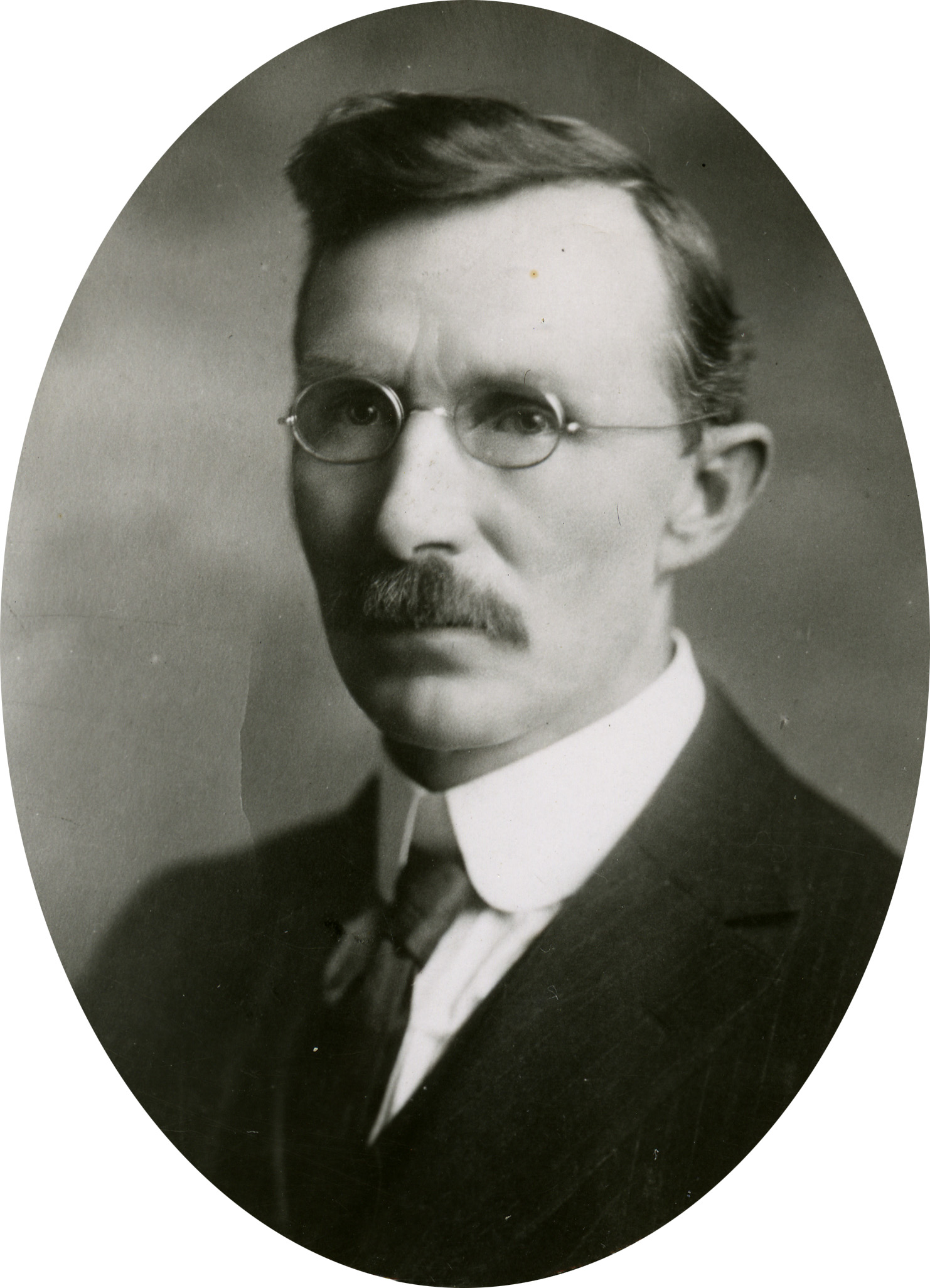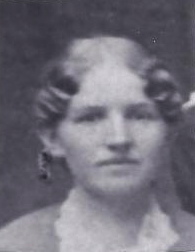Photos
Right-click [Mac Control-click] to open full-size image:

George Albert Adams

Nancy Evelyn 'Eve' Mortensen
George Albert Adams
Born: 4 December 1864 at Paragonah, Iron, Utah Territory, USALIFE SKETCH GEORGE ALBERT ADAMS
George Albert Adams was born Dec. 4, 1864, in Paragonah, Utah, the oldest child of William Adams and Mary Barbara Bolanz. Mary Barbara had been married, had one daughter, and was widowed when she was 18 years old.
She was disowned by her family after joining the Mormon Church. She came to America and crossed the plains in a handcart company. George grew up on a dairy farm in Iron County, Utah, near Parowan, living on the farm in the summer and attending school in Parowan in the winter. As he grew up, he worked with his father, caring for the cattle which ran the open range the year round. He learned early in his life to ride horses, camp out, round up cattle and was accustomed to all the rigors of frontier life.
In 1877, the family of Lars Mortensen moved on the Adams Ranch. One of the children was a little tow-headed girl, 2 years younger than George, and from this acquaintance, there was a boyish affection created that finally developed into true love.
In the spring of 1881, William Adams and his family were called to assist in settling the San Juan County. Before leaving Parowan, George entered into an agreement with his "best girl” to wait for each other and be married a few years later. This they did.
They were married on 22 April 1885, in the St. George Temple. George says, “From my youth I was taught the benefit of prayer and followed this practice through all my life, in which I acknowledge my Heavenly Father in guiding me from time to time, and especially in the union of one particular Adam(s) with his Eve." (Evelyn Mortensen)
George spent the year 1882 in San Juan. Because of this move, he was unable to go to school, which he missed, but appreciated the benefits of the Church and realized he was gaining invaluable experience for his later life. He went to Parowan occasionally and renewed his pledge with Evelyn. Mail was very uncertain then in San Juan, and the two young lovers would often go for months without hearing from one another. To get to Parowan from San Juan, and vice versa, one had to cross the Colorado River, and the only way to cross it, with a herd of cattle they were usually driving, was to swim. Sometimes the animals refused to enter the turbulent stream, so it took considerable force and contriving to get them across. George, with his father and brothers would buy cattle in Parowan, take them to San Juan to fatten them, and drive them back to Parowan to sell them. George showed his good business sense by buying calves and yearlings. After a year of good food, he could sell them for 3 times as much as he paid for them.
George learned to get along with the Indians. He tells of one experience when a young Navajo challenged him, first to a rough and tumble fight. George knew how to do that and soon had the Brave at his mercy. Then he was challenged on an archery contest. He won this also. Then they wanted to try him on a race. He said if they had wanted a short race he could have won easily, but they placed it at 200 yards, and he found he was no competition for the Navajo Indians. However, they parted friends.
He was on a visit to Parowan in the winter of 1885 when he and Evelyn decided to get married. They made the trip to St. George to be married in the Temple. Both of them attended school in Parowan until he had to go back to Bluff with the cattle. He left his young wife with her family while he drove the cattle. They had a hard time getting the cattle to swim the river and it took them much longer than they had anticipated. They ran short of provisions, but found fish in the river, and George caught a 'salmon,' which was 4 feet long. Since they were having so much trouble with the cattle, George decided to get help, so he rode into Bluff, 100 miles from the river, and brought supplies back to his comrades. His brother, Frank, and Tha1es Haskell Jr. returned with him, and he and Frank continued on to Parowan. The next winter he and Frank both remained in Parowan and he went to school until April 1866. George and Evelyn's first child, Mary Cornelia, was born Jan. 28, 1886.
School closed in April, so George and Frank took a light wagon and went back to Bluff, a quick and successful trip. He then purchased a small log house, remodeled it and, made it a respectable place to live for that time and place! In June, his wife made the trip by train to Thompson Springs, 176 miles from Bluff. George took a 4-horse team and wagon and met her and her father with their household furniture. They still had to cross the River, which was very high and rough. They had to take the wagon apart and go across the river on a small ferryboat. It took several dangerous trips to complete the transfer. Getting the horses over almost capsized the boat. The memory of this event stayed with Evelyn almost all her life and she dreaded to cross the Colorado. She did not see her mother again until the Mortensens moved to Sanford, Colorado.
The young couple became part of the life of the town of Bluff. They took part in Church Socials and political rallies. Any entertainment had to be strictly of their own making. They loved to put on plays. The men would make up exploring parties and go all over San Juan County. They had to contend with the Indians the desperadoes who sometimes came to this land to hide or to cause trouble. They had to provide irrigation water and insist on public water rights. They ran cattle, milked cows and made cheese.
In l888, George moved his family to Verdure, a new settlement on the South Montezuma Creek. He built a 3-roomed house and purchased a farm and raised wheat and oats. The oat yield would run as high as 100 bushels per acre. They had to cut the grain with a cradle and bind the sheaves by hand, threshing it with an old-fashioned thresher run by eight horses.
The roads over the mountains were almost impassable in the winter months. Unsuspecting travelers would be caught in the snow and it seemed to George that he made a regular business of getting people out of the snow. One time Evelyn and her sister decided to go to Verdure from Bluff without telling anyone. They got in the snow so deep the horses lay down and refused to move. The women with the baby tried to walk carrying the year old Mary Cornelia. A friend making the trip in a light sleigh found them and saved their lives.
The Indians were always with them. If an Indian was killed by an unscrupulous white man, they would go on the warpath and everyone was in danger. Thales Haskell was an Indian Scout, interpreter and peacemaker. The Adams treated the Indians kindly fed them and always tried to keep the peace. Everyone came to their home. They entertained Governor West, George Q. Cannon, General Lawton, General Scott, and Apostles of the Church as well as Indian Outlaws Polk, Posey and Iznegat.
George served as Justice of the Peace, Assessor, Superintendent of Schools and County Attorney. This was in the territorial days when money was put out to outlaw cattle thieves. When the outlaws saw that the settlers meant business, they scattered in all directions. The few thieves, which were caught and convicted, had to be sent to Beaver 300 miles away, for their trial; George said he had contributed no small amount of money to the “outlawing “of outlaws.
He served as a Missionary to the Southern States for 2 years. He also served as a Home Missionary for 6 months, was the Bishop of Monticello Ward for one year and was a counselor for the Stake Presidency for many years. He served one term as Representative in the House of Representatives in Salt Lake City. During World War I, he served as chairman of the County Finance Committee for 2 years.
George Adams, from his daughter Cornelia's sketch of him, was a good man, tolerant and hospitable. The family's hospitality was proverbial - they never ate a meal alone. Indian, White, friend or foe were all treated alike. If strangers came to him asking for charity, he would hire them to work on his ranch until they were able to stand on their own feet and become useful members of the community. His children worked with him and developed into able men and women.
He built the first modern home in Monticello about 1912, a fine 2-story brick building. His son Donald still lives there as an alternate home to his Salt Lake residence.
He had very little formal education and he was determined to his children should not be thus handicapped. Each child had an opportunity to go away to the schools of Utah or Eastern Colleges. He loved to spend time with his children and would spend long evenings telling them of his missionary experiences, and in this way teaching them the Gospel. His days began and ended with prayer and his children knelt with him.
He loved good things and took every available opportunity to improve himself. He loved to go to Salt Lake for special events, Conference, Political Conventions, Tabernacle Choir Concerts, plays and to do Temple work.
George died on May 8, 1935, in Salt Lake City after his leg had been amputated because
of Phlebitis. He was buried in Monticello.
Sources:
1
Sketch and autobiography found in memories on Family Search
2 Photo of George courtesy of San Juan Historical Society
Right-click [Mac Control-click] to open full-size image:

George Albert Adams

Nancy Evelyn 'Eve' Mortensen